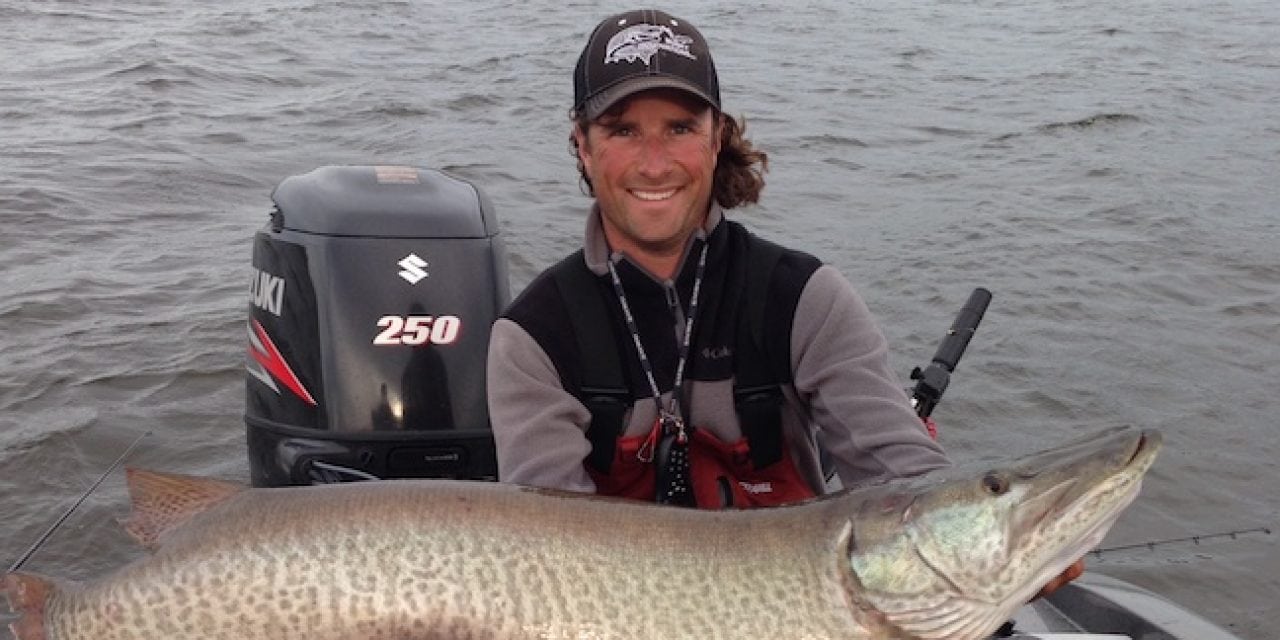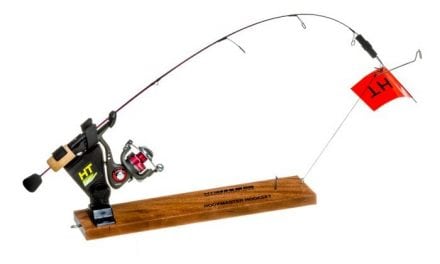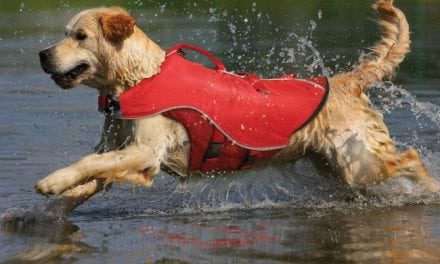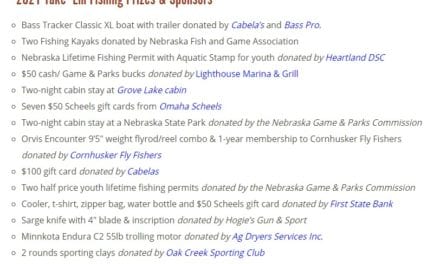These are the best places in the U.S. to catch truly world-class muskies.
Inherently, anglers who choose to chase muskies are trophy hunters.
Certainly, the overall time expenditure in angler efforts as compared to success is pitiful; those with strict adherence to precepts of common sense would never attempt it.
However, once addicted, for many anglers muskie fishing turns into a quest for the super beast.
World-class muskies exist at a level above what most anglers ever see.
For fish to attain world-class trophy sizes, they need the perfect mix of genetics, forage and big water.
What qualifies as “World Class” is pertinent; among some trophy hunters, the consensus is that true 50-pounders are world-class muskies. I’d say that a case can be made for beginning at 45 pounds, as in the majority of fisheries, the largest females never attain that size.
Looking at historical record fish obviously helps give perspective on this question, but, to make a very long story short, expert researchers have proven that some historically-claimed sizes were stretched.
A who’s who of muskiedom on the North American continent comprises the Modern Day Muskellunge World Record Program; its record fish is a 58-pounder.
Let’s take a look – from west to east – at the best fisheries in the United States for behemoths.
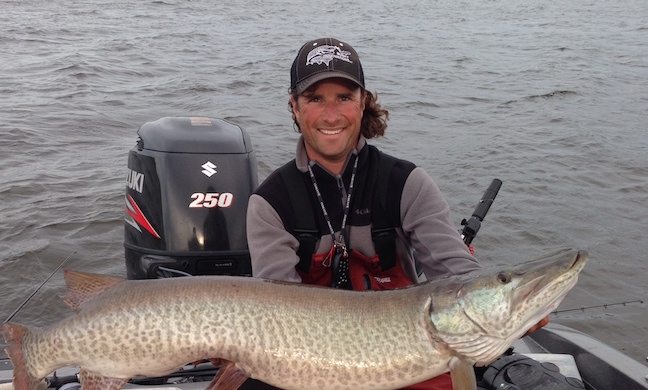
Guide Luke Ronnestrand with a Mille Lacs trophy muskie. (Photo by Pete Maina)
MILLE LACS LAKE, MINNESOTA
Mille Lacs Lake, located in central Minnesota, comprises 132,000 acres and has a maximum depth of 42 feet.
It’s laden with forage, including a population of large tulibees.
There are two stand-out Minnesota trophy waters (in addition to Mille Lacs, Lake Vermilion is a true trophy fishery). Luke Ronnestrand guides both of them — as his clientele are trophy seekers like he.
On a personal note, I’ve been seeking trophy muskies myself for more than three decades, and Mille Lacs is the only place I am certain I hooked a 50-pound muskie.
I was filming a TV show and, sadly, filmed the fish spitting the lure back. I thought it was huge fish, but I didn’t realize how big it was until 40 minutes later, when I caught a massive 53 1/2-inch muskie; witnesses to both fish all agreed the one I lost was significantly — almost frighteningly — larger.
Ronnestrand says Mille Lacs provides the best opportunity for a 50-pounder in Minnesota.
There’s nothing easy, though. Mille Lacs and Vermilion received similar muskie stockings during the 90’s and into 2000; and by the early 2000’s were exceptional with regard to both the numbers and size of fish they produced.
With increased angling and some harvest pressure, the numbers of muskies fell and the remaining fish got much smarter. Nevertheless, the size of many of these fish is simply amazing. And despite the education angling pressure has given them, they remain fish and can, therefore, still be fooled.
The water here has huge structures: long breaklines with weeds, open water, mud flats and rock bars.
The sheer number of places to seek can be a challenge for anglers. Adding to the difficulties of searching these areas is the fact that waves can be an issue: there is no protection from wind excepting the lee shore.
Still, most of the direct muskie fishing pressure is done via casting; time on the water allows anglers to pinpoint fish location and Leech lake strain muskies (stocked in these lakes) do group up, so one fish often means more.
In recent years, more trolling has been employed effectively on Mille Lacs to target open water. Ronnestrand recommended searching the top 10 feet of the water column, regardless of depth.
His favorite times for big girls include the first major moon phase in July. One of the most effective tactics involves placing large spinners (Cowgirls) on deep weed edges, especially under low-light conditions (dusk, dawn) and after dark.
Ultimately, the late fall period is best, when water temperatures get in the 40’s.
The big muskies follow that forage base of large tullibees as the forage fish head to hard-bottom areas to spawn. Large soft plastics comprise the most effective presentations.
In northeastern Minnesota near Cook, Lake Vermilion is a piece of the Canadian shield – essentially a polar opposite in look, layout and structure to Mille Lacs. Vermillion’s 40,000 acres are spread out and dotted with rock islands and reefs.
Like Mille Lacs, it too has great forage, including large tullibee and perch. The number of muskie per acre is higher and odds of catching a muskie over 53 inches here is exceptional (comparatively, of course).
Ronnestrand said it’s essentially five shield lakes in one: each basin has its own look and fishes slightly differently from the others.
Like Mille Lacs, even with all the structure, many of the Vermilion muskies are open-water creatures, so trolling those zones can be effective with similar tactics.
Casting is king, though, and Ronnestrand’s favorite time is August and into September. On dark, windy days he finds a good spinner and topwater bite on the eastern side, while bright sunny days offer a great bite on soft plastics along deep-water rock/weed edges to the west.
Vermilion can produce a tremendous night bite lake as well. That same pattern — targeting fall-spawning tullibees — applies.
October is a good month in general and he stresses that in addition to rocks, weeds are relevant right into November and should be checked. For certain on this water: there is never boredom in looking for juicy spots to fish. Luke guides out of Vermilion Dam Lodge.
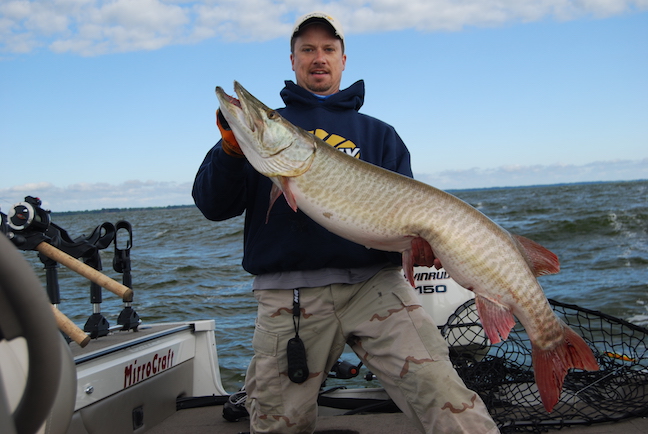
Capt Kevin Pischke with a 50-inch muskie caught while trolling in September 2013. (Photo by Pete Maina)
GREEN BAY, WISCONSIN
Green Bay is the place in Wisconsin for world-class muskies. Great Lakes Strain muskies stocked in the 90’s and beyond, in addition to a massive forage base and room to roam, have combined to produce an exceptional trophy opportunity.
Kevin Pischke guides these waters; he observes that in addition to gizzard shad and many other species, a surge of whitefish has added significantly to the muskies’ forage base in recent years.
Muskies here are reaching upper 50 inches; 40- and 50-pound muskies have been caught and released in recent years.
Where to concentrate efforts may be the toughest part for anglers to figure out. The trophy fish here travel, following forage (shad, whitefish) as they move.
Trolling makes the most sense on the wide open spaces — and that is how Pischke spends much of his time. Nevertheless, there are also many casting opportunities in the many tributaries and some distinct structures that exist.
Spring is great time to hit the water. Spring anglers should concentrate on rivers where muskies go to spawn. Following the spawn, the fish back out of the rivers gradually.
The Fox River right in town provides great fishing every spring; Pischke noted that muskies often sit in very shallow water (as shallow as 1 foot).
In summer, he suggests checking the emerging weeds; this is the tough part, of course, as they exist in the lower bay and on up, especially on the west side.
Trolling a variety of spinners and crank baits is very effective. Pischke keeps an eye on water clarity and weed globs as well; dirty water and excessive floating weeds can destroy an angler’s odds.
Late fall is prime time and here again following forage is key; the lower bay will hold muskies as shad move in there; deeper water and sharp breaks on the main bay will be good as well.
An interesting item here is the fact that smaller (6 to 8 inches) crankbaits are very effective and often preferred, even by the largest fish, over larger baits.
Local anglers theorize that these baits most effectively match the shad forage. They will hit big cranks too, but in late fall when it’s popular to troll and cast all big stuff, it can be a big mistake here to not try small.
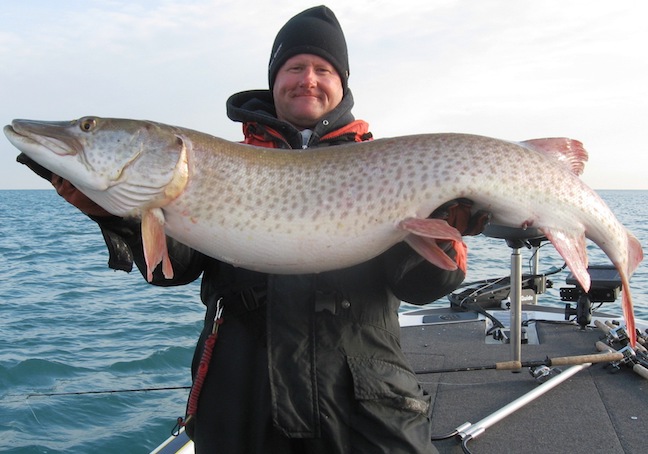
Guide Jon Bondy hoists a trophy muskie from Lake St. Clair. The “fall fattie” was taken in November. (Photo by Pete Maina)
LAKE ST. CLAIRE, MICHIGAN
Lake St. Claire may be the most amazing muskie fishery on the continent.
I love and hate it — as it’s huge and somewhat ugly; towing a boat in Detroit city traffic is weird, and yet it’s a tremendous muskie fishery, offering the very rare combo of a shot at numbers of fish and a world-class trophy on the same day. And, it’s a completely natural fishery, with indigenous great-lakes strain muskies that are naturally reproducing.
Strangely, the great lakes to the north and south don’t have viable populations for angling. Something is very different with regard to the make-up of St. Claire.
These waters are rich with muskie history and lore, having been known for decades as a trolling destination for anglers seeking large numbers of muskies.
The big lake has 420 square miles of water with a mean depth of 10 feet.
Because there’s so much water to cover — whether it be huge weedy flats, open water or river channel – historically trolling has been both very effective and popular.
And it still is: Charter captains may score double-digit days of muskie captures, a success rate that is virtually unheard of anywhere else in muskiedom.
More than two decades ago my first attempts to fish there involved trolling — and we got muskies, but fish were underweight for length.
Since then, two things changed distinctly: first, in early 2000’s I started casting (I wasn’t first to do this, but it was rare) and found success.
Second, in 2006 there was a significant muskie die-off attributed to VHS disease. While the die-off involved less than 5 percent of the adult population of muskies, it rightly had some anglers scared.
No one knows exactly what occurred in lake dynamics, but it was — partially at the least — good news. The muskies’ reputation for being skinny changed significantly; fish above 55 inches with heavy builds have been caught since.
Casting weeds can be very effective; pattern fish by weed thickness, weed type and depth. Populations of muskies occur in the St. Claire river system to the north and Detroit river south; in these rivers current is an additional patterning key.
A very effective non-traditional muskie tactic here is vertical jigging; and not just late fall. Jon Bondy guides here and has popularized vertical techniques as well as building a whole line of lures around it. He does very well in the spring too.
Vertical presentations can work anywhere, but it’s especially effective in the current areas of the St. Claire, Detroit and Thames.
The fast current that exists often puts muskies on the bottom, to allow them to avoid fighting the current and at the same time to see what forage the the river brings to them. Vertical presentations shine all year and produce some monster fish.
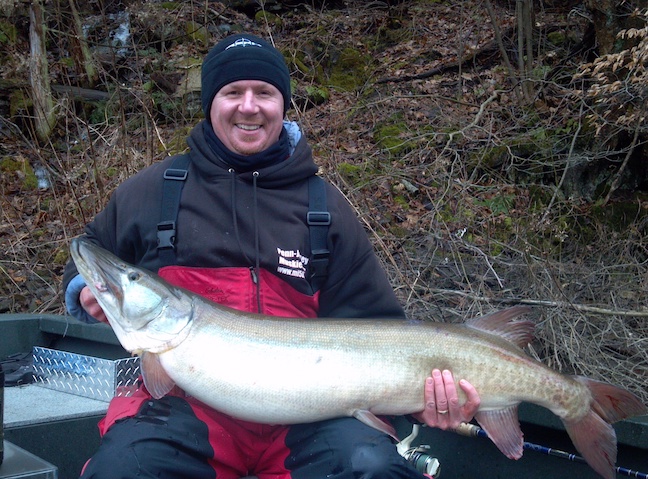
Guide Red Childress hoists a trophy muskie. (Photo by Pete Maina)
ALLEGHENY RIVER, PENNSYLVANIA
Located in the northwestern portion of Pennsylvania (with a stretch in New York), the Allegheny River stretches some 325 miles and includes a reservoir created by the Kinzua dam.
Red Childress guides here, spending most of his time on the river stretch below the dam and south, but also the reservoir above. All of it produces massive muskies.
The upper end of the growth range in length is 50 to 55 inches. This may not sound world-class to some, but the build on these fish is way above average: 40- and even 50-pound fish are a possibility.
Suckers, trout and large dace offer part of the food source. There is natural reproduction occurring, mainly in the middle stretch of the river, aided by stocking of Ohio strain muskies throughout.
While the lower section is more navigable, the middle and upper sections require use of a jet boat to navigate due to rocks and wood. This reduces angling pressure and Childress likes to take advantage of these quieter waters.
He finds most activity in the 2- to 15-foot range, plying rocks and logjams as well as weeds and some gravel areas. Current is significant, averaging 3 to 4 mph, so any current break has potential.
A variety of lures, chosen to fit the depth zones targeted, will work well. Childress is an advocate of mixing it up, with everything from topwater lures to soft plastics.
Late fall and winter are the prime periods to go after world-class muskie here.
Those periods are also the best for predictable fishing: fish generally deeper most of the day, though checking shallower water at midday can pay off, and avoid shallows on cold mornings.
Spring and summer can be good as well; in warmer weather weeds can be especially effective.
Childress also fishes the reservoir, which is 27 miles long with 90 miles of shoreline.
Ultimately, the reservoir is where the biggest fish of all live. It’s big and deep water here – so Childress relies mainly on trolling as a method throughout the season.
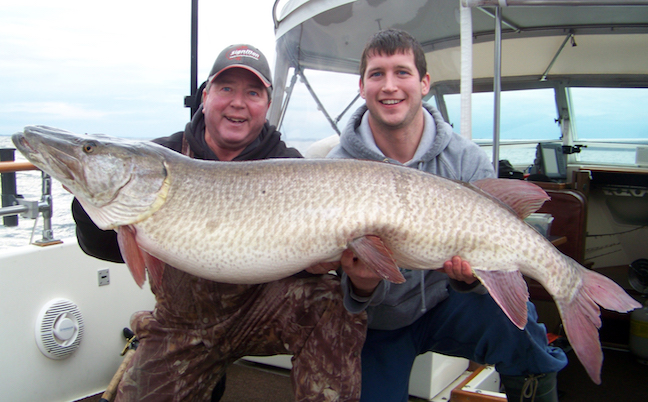
This 60-inch muskie — quite possibly the largest muskie ever released alive by an angler — was caught by Daniel Polniak, Jr. (right), of Ogdensburg, NY from the St. Lawrence River while on a charter with guide Rich Clarke (left). The fish had a maximum girth of 29.5 inches. (Photo courtesy of Rick Clarke)
LAWRENCE RIVER, NEW YORK
The ultimate potential for a world-class monster is found in the the St. Lawrence.
Muskie-crazed anglers seem to agree: the upper range on the best of the best fisheries across the continent top off around 58 inches.
But in the S. Lawrence, 60-inch fish seem to be a real, if remote, possibility.
If a fish like that happened to be caught in the fall in peak condition, that fish could reach the 60-pound range.
Rich Clarke, of Signman guide service, has been fishing the 1000 islands area of Clayton, New York, for more than 50 years.
He noted the forage base in the river is amazing, with alewife, lake herring, yellow perch — and, in recent years, a rapidly increasing population of gobies.
They average 4 inches in length, but get up to 9 inches — and everything eats them. The bad news is that because eating is easy for the muskies, they are often stuffed.
A full muskie essentially just hangs out, and can be a tough customer for anglers hoping to get that fish interested in lure.
In recent years feeding windows have become tighter, with increasing instances of “play” strikes; teeth marks from these has become part of the patterning process.
For those who love to cast, there are distinct areas (points, rock piles and breaklines) that can be tried.
Rich mainly targets muskie via trolling – as this water is huge and deep; the breaks are sharp – 18 to 60 feet is a good target zone, but Clarke also finds muskie out in open water as well.
Because of the aforementioned overfed fish, he watches rods for those play strikes, checking for teeth marks in lures — anything that may give away fish location and lure preferences. He patterns first by lure size and action and, of course, depth.
He stresses this is not an action fishery, yet he still sees an overall size increase in the fish.
As the St. Lawrence is border water, Canada has maintained a 54-inch size limit for some time; Rich confirmed that the U.S. minimum will be set to match that.
Prime times include the period from mid-August through September; the ultimate time for maximum weight and a super-giant would be late fall.
(Note: This article was written for Game & Fish Magazines in 2015)
MUSKIE CONTACT INFORMATION
If you’re interested in fishing with any of the guides mentioned in this article — or if you like looking at websites with pictures of big muskies — you can do so using the following information:
- Luke Ronnestrand (Mille Lacs and Vermilion), 952-807-2947
- Kevin Pischke (Green Bay)
- Jon Bondy (Lake St. Claire)
- Red Childress (Allegheny)
- Rich Clarke (St. Lawrence)
The post 5 Best Spots for World-Class Muskies appeared first on Game & Fish.

